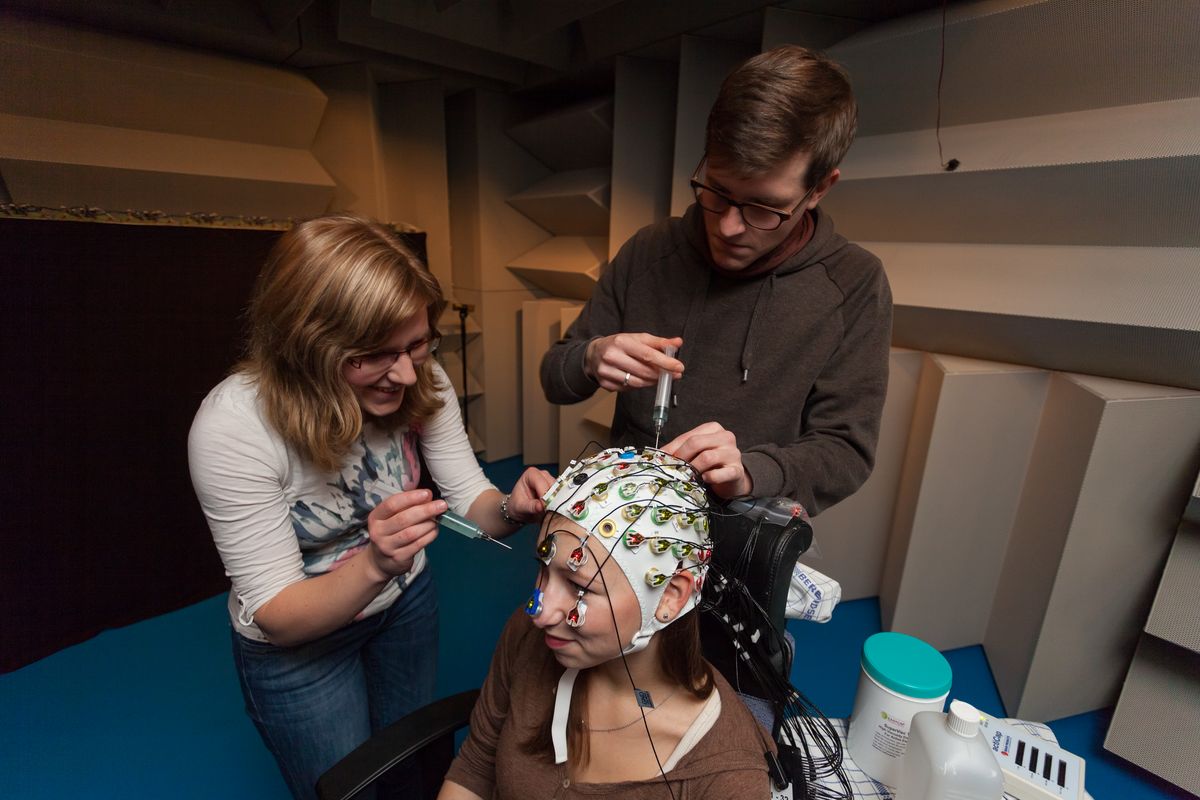Our research focuses on sound processing in higher auditory brain structures. Currently, we investigate human auditory system, with an expansion to incorporate rodent model systems under way.
Our Research
We are interested in how the brain encodes and processes simple and complex sounds and how these mechanisms change when people adjust to new listening situations. These studies address basic mechanisms of sound processing that underlie all higher human auditory functions, such as speech and music perception. We are especially interested in looking at individual brains, rather than group averages, with the aim of understanding how differences in brain processing relate to differences in perception and behaviour. We use high-resolution functional magnetic resonance imaging, EEG, brainstem recordings, computational modeling, and a number of somewhat crazy devices and techniques, such a our self-build 80-channel spherical loudspeaker array and miniaturized programmable devices that change the way people hear. In addition to pure science, we try increasingly to address clinical questions about hearing disorders with these methods. Additional lines of research and techniques include interactions between sound and pain in the auditory brainstem, machine learning analysis of brain imaging data, age-related changes in plasticity and spatial hearing, and brain responses to expected but absent sounds.
Funded projects
Optical Imaging (start-up funds, Leipzig)
We are currently setting up a new optical imaging facility at Leipzig University lab with the aim to image rodent auditory cortex (in-vivo epifluorescence of genetically-encoded Ca2+ indicators) and the medium-term goal to add an awake behaving preparation. Rodent training and EEG set-ups are also in the works.
Mapping brain plasticity and behavioural adaptation to simulated hearing disorders (Canadian Institutes of Health Research)
The main aim of this line of research is to develop reversible models for hearing loss and tinnitus. One of the difficulties in studying brain changes caused by these hearing disorders is that we can only measure brain activity after the onset of the hearing problem and it is thus impossible to isolate brain changes specifically caused by the disorder. We use a technique that allows changing a person’s hearing and simulating a hearing disorder in a healthy person over several days.
Auditory Cortex: Pathways, Processes, and Plasticity (Canadian Institutes of Health Research, with Robert Zatorre)
The general aim of this line of research it to characterize the intrinsic organization of auditory cortex, as well as its interactions with brainstem structures, dorsal and ventral cortical pathways, and the reward system.
Central gain modulation and rehabilitation of workers with tinnitus (Institut de recherche Robert-Sauvé en santé et en sécurité du travail (IRSST, co-PI with Sylvie Hebert)
This grant supports several experiments in a collaboration with the lab of Sylvie Hebert on the mechanisms of tinnitus in the human brain.
In-ear realtime sound modification (Leaders Opportunity grant from the Canadian Foundation for Innovation)
The Canadian foundation for innovation funds novel equipment and infrastructure. This grant allowed us to build and validate the programmable earplugs and portions of the 80-channel loudspeaker array in our Montreal lab.
In-ear realtime sound modification as a tool for basic research in auditory perception (NSERC Discovery grant, PI)
This grant supports research with the electronic earplugs. We use the plugs to change spatial sound perception, filter out frequency bands, insert noise, etc., and follow participants with brain imaging and behavioural testing as they adapt to the modified sound perception over a few days or weeks.
Mapping the human auditory cortex: low-level features and higher-order interactions (Canadian Institutes of Health Research, with Robert Zatorre)
Responses in auditory cortex are driven by sound and modulated by experience, training, and context. We try to understand these interaction in this line of research by mapping brain responses in auditory cortex and higher areas when people are passively listening to sounds, during learning and training, and when they are performing different tasks.
Center and network grants
CRBLM / BRAMS (funded by FQRNT, CFI)
The Centre for Research on Brain, Language and Music (CRBLM) is a multidisciplinary research centre focusing on research on the human faculties of language and music. The centres provide technical and financial support for state-of-the-art research infrastructure, offer training for faculty and students, and fund research. Have a look at the article in Science about BRAMS.
Erasmus Mundus Exchange Network in Auditory Cognitive Neuroscience (European Commission, 2.45 Mio Euro, 2010 – 2017)
The network is as large as it’s name is long – 26 universities and institutes in 11 countries in Europe and North-America. It supports transatlantic exchanges of doctoral and postdoctoral students and staff members, who typically spend a few months in a partner institute across the Atlantic as part of a joint research project (see program web page).
